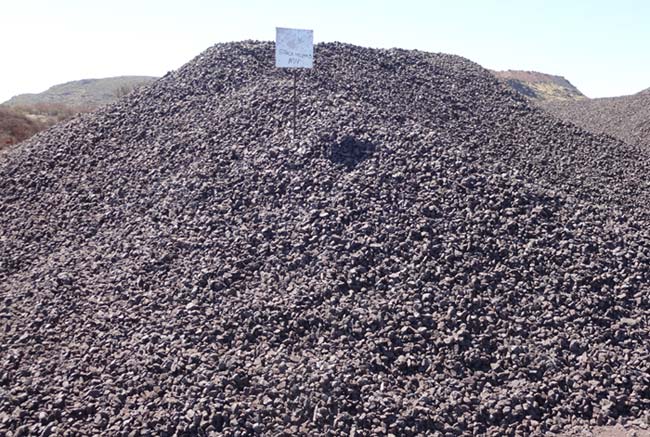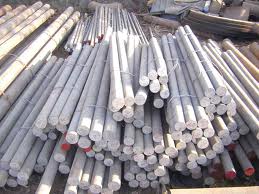

| Symbol: | Mn |
| Melting point: | 1,246'C |
| Electron configuration: | [Ar]4s23d5 |
| Atomic number: | 25 |
| Atomic mass: | 54.938045±0.000005u |


| Ore | Common Name | Formula |
|---|---|---|
| Oxide | Pyrolusite | MnO2 |
| Oxide | Pollianite | MnO2 |
| Oxide | Franklinite | (Fe,Zn,Mn)(Fe,Mn)2O4 |
| Oxide | Hausmannite | Mn3O4 |
| Hydroxide | Psilomelane | MnO,MnO2.2H2O |
| Carbonate | Rhodochrosite | MnCO3 |
| Silicate | Rhodonite | MnSiO3 |
| Sulphide | Albandite | MnS |
Manganese is a light and a hard metal. It is grayish -whitish in color. It is used as de oxidiser in the production of pig iron and steel. Ore of manganese contains manganese and iron. In many cases, it is used for extraction for ferromanganese. It is also used for production of silicomanganese. In ferromanganese, manganese may vary between 15-80%. In silicomanganese, the silicon percentage is between 10-20% and the remaining percentage is manganese. Manganese oxide ore is used in batteries, paints and barnishes. Sodium and potassium permanganates are produced from manganese compounds. These are used as disinfectants. Manganese oxide ore is also used in leaching of uranium ores. Manganese metal is mainly used as an alloying element of steel. It is also used as an alloying element of copper and aluminium alloys. Manganese oxide ores are also used as coloring agent in glass and ceramic industries. Around 95% of the total manganese production are used in total steel industries.
Pyrolusite is the oxide ore of manganese. It is the most important ore mineral of manganese. The oxide ores are mostly found in sedimentary deposits. In the sedimentary rocks, the manganese oxides precipitated in beds as manganese nodules. Manganese ore is also found deposited with iron ores. Some of the manganese deposits are formed by leaching of manganese oxides from silicate minerals. These materials are deposited as nodules and residual lateritic deposits. Major producers of manganese ores are Russia, South Africa, Brazil, Australia, Gabon, China, India and U.S.A. The important minerals of manganese are given as follows:
The minerals like Spessartite and Manganese Garnate also contains sufficient amount of manganese and can be used for extraction of manganese. Manganese oxide minerals are formed by breaking of manganese bearing silicates. Large deposits of ferro manganese nodules occur in the basins of pacific ocean, Atlantic ocean and Indian ocean. These nodules are found at depth of 5 km. The origin of these nodules are biological and chemical. Manganese ores are grouped into different grades as per their contents of manganese and iron.
| Battery grade | MnO2(72% and more),Fe(less than 7%) |
| Chemical grade | MnO2(75% and more),Fe(less than 1.5%) |
| Ferromanganese grade | Mn(46% and more), Mn/Fe(4.6 % minimum),P(0.2% or less) |
| Blastfurnace grade | Mn( 25-35%),Al2O3(7.5% or less),SiO2(13% or less),P(0.2% or less |
| Ferrosilicon | Silicon(50%-90%), Iron(18%-48%), Carbon(up to 2%) |
| Ferromanganese | Silicon(78%-82%), Iron(10%-15%), Carbon(up to 7%) |
| Silicomanganese | Silicon(56%-66%), Iron(28%-32%), Carbon(up to 1%) |
Ferromanganese, silicomanganese and ferrosilicon are used as deoxidizers in the iron and steel production. These ferroalloys are also used as alloying additions with non-ferrous metal. Different type of ferromanganese is produced for special grade steel. The manufacture of highly strong steel such as Hadfield manganese steel requires significant addition of ferromanganese. The ferromanganese with desired composition is to be produced for making of special steel. The ferroalloys are produced in various grades. These gradations of ferroalloys are given as follows:
In addition to ferroalloy & manganese ore is used in refining of pig iron. Manganese oxide is the most stable oxide produced during refining of pig iron.
Iron and manganese form ideal solutions and even in the presence of other solutes, ideal behaviour is assumed. Manganese oxide is soluble in slags.
FeO + Mn = MnO + Fe
FeS + Mn = MnS + Fe
Similarly, silicon content decides the grade of pig iron. It strongly interacts with iron to produce appreciable quality of pig iron. Ferromanganese, ferrosilicon and silicomanganese are produced in submerged electric arc furnace. In case of ferromanganese, the raw material is manganese oxide ore, iron ore and coke. The charge is put in the furnace. Current is switched on. After some time, the coke starts burning and produce carbon monoxide and carbon dioxide. The reduction process starts and oxygen is separated from the manganese and iron. To remove impurities like silica, limestone is added as flux. Oxygen is blown to the furnace. The impurities form the slag with lime and moves to the surface of the molten ferromanganese. The ferromanganese is separated for future use. The slag is removed to the dumping site. The silicomanganese is produced by the use of manganese ore, silica and coke as the raw materials. The process is similar to ferromanganese production. The ferrosilicon is produced with raw material as iron ore, silica and coke